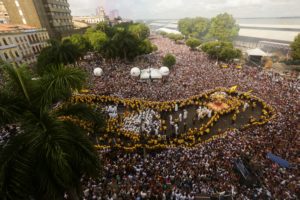ROME — There’s a tendency in journalism to over-interpret virtually every development or trend that comes down the pike, in order to lend our stories sex appeal. “Nothing really to see here” might well be the truth of many situations, but it’s hardly a prescription for drawing eyeballs or selling papers.
So it is that over the past 11 years, reporters and commentators on the Francis papacy have tended to play up perceptions of a rift between the liberal pope and a more conservative church in the United States, particularly as it concerns the American bishops — and, of course, there have been just enough outspokenly dissident prelates in the country to keep that narrative alive.
Reality, however, is a bit less dramatic than these perceptions of fractures and schisms would suggest.
The most recent Gallup survey, released in mid-January, found that Francis enjoys a 58% approval rating among Americans generally. When you consider that the two major party candidates for president, Donald Trump and Joe Biden, currently have approval ratings of 42 and 38 percent respectively, the pope’s comparatively robust support can’t help but seem fairly impressive.
More remarkable still, Francis is seen positively by 77% of American Catholics. Given the notoriously fissiparous state of American Catholic opinion on most matters — let’s face it, it probably would be tough to get 77% of American Catholics to agree on what day of the week it is today — that too seems striking.
Granted, Gallup also found that Francis’ negatives are now at all-time highs, both among the general population and with Catholics specifically. Yet after 11 contentious years in office, and in an extremely polarized era, the fact that the pope still has such strong overall backing probably should be the biggest takeaway.
With that caveat, however, there’s equally no denying the fact that the Francis era has been a turbulent period for the church in the U.S. In both substance and style, history’s first pope from the developing world has sometimes proven disorienting for many American Catholics.
Ad extra, meaning in terms of the Church’s engagement with the wider world, Francis is reorienting Catholicism, and the Vatican specifically, away from being a predominantly Western institution to a truly global one. His policies on China, for instance, or on Ukraine, or on Gaza, align far more closely with those of the “BRICS nations” (Brazil, Russia, India, China, and South Africa among them, as the acronym suggests) than they do with the White House, even under a liberal administration led by a Catholic and self-professed Francis admirer.

Ad intra, with regard to the internal life of the Church, Francis is pursuing a program of “synodality,” a difficult term to define with precision but which, in broad strokes refers to a more participatory and inclusive ecclesial approach, rooted in compassion and dialogue, and with less emphasis on some of the traditional moral battles which have defined Catholic identity in America in recent decades, especially with regard to “life issues” such as abortion.
Both of those transitions have been trying for some sectors of American Catholic opinion. To some extent, the tensions overlap with the usual left/right divides, though not exclusively so. Many American liberals, for instance, may find Francis’ refusal to forthrightly condemn Vladimir Putin, for example, even more frustrating than conservatives, some of whom feel a certain grudging admiration for the Russian leader.
Standing back from the particulars of any given issue, what seems clear about American reaction to Francis that it cannot properly be understood in isolation, but rather as part of a more epochal shift in Catholicism — to wit, the rise of a global Church, one in which the United States simply is not the pivot point.
A bit of math makes the point: There are 1.3 billion Roman Catholics in the world today and just over 60 million in the United States, which means that Americans account for slightly under 5% of the global Catholic population. Put another way, 95% of the Catholics on the planet today are not Americans, and do not necessarily see the world through the lens of American experiences, interests, and priorities.
Two-thirds of the world’s Catholics today live outside the boundaries of the West, in Africa, Asia, Latin America, the Middle East, Eastern Europe, and points beyond. By 2050, that nonWestern share will be three-quarters.
In such a far-flung global community of faith, Catholics in the U.S. increasingly will be pressured to make their peace with the reality that the Church, and its leadership, will not always react from within American categories or according to American logic. Right now, the tensions unleashed by this transition are focused on Francis, but they just as easily could be aroused by a pontiff from Congo, or Sri Lanka, or Myanmar — all, by the way, at least remotely plausible candidate nations to give the Church its next leader.
To be clear, American Catholicism is hardly sliding toward irrelevance in global Catholic affairs. The church in the U.S. wields mammoth resources, both human and financial, including by far the world’s leading network of Catholic institutions. They include schools and universities, hospitals and clinics, social service centers and humanitarian organizations, and on and on.
Nevertheless, American Catholics need to be clear that the turbulence of the Francis era is not a one-off affair triggered by the idiosyncrasies of a gaucho, or cowboy, pontiff. It is, instead, a harbinger of things to come — perhaps not always in service to the same agenda, but unlikely to be predictably “American” in tone or content either.
To put the point differently, the Francis papacy will pass, as all papacies eventually do. Yet the new and more complicated era in the global Church he embodies, with both its promise and its frustrations for Americans, appears here to stay.

